
Quick Tips
- Cleaning latex paint from a paint brush.
- Removing fresh latex paint from a paint brush.
- Removing old latex paint from a paint brush.
- Cleaning oil-based paint from a paint brush.
- Removing new and old oil-based paint from a paint brush.
- What to do with old and used paint thinner.
It was the mid-90s, and I was still a teenager. One summer morning, my father asked me to paint the basement walls, and I proceeded to put it off month after month. Finally, right before he left for work one morning, he told me that if I didn’t get it done that day, I would be in deep trouble. So, I hauled myself out of bed, opted to stay in my pajamas, and began prepping for the task. I laid down my canvas drop cloths, and began to prime the walls. About an hour into my work, I heard movement upstairs, and my dear, sweet grandmother (God rest her) calling out to see if anyone was at home. It occurred to me that the situation would not look good to her. Here I was, a teenager, alone, two stories away from my pants, and in the basement with the computer that had Internet (where porn lives). That my arms, shirt, and face were spattered with white, viscous ooze was fuel for the fire.
As there is no force on this Earth that will get me to tell you the end of that story, let me move on to the subject at hand. Cleaning your paint brushes after a hard day’s work is, generally speaking, quite easy. However, some of the chemicals required are very toxic and very dangerous, so special consideration and attention needs to be paid. Read on, and I’ll explain.
Cleaning Paint from a Paint Brush
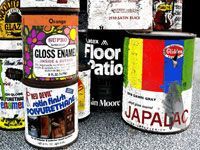 Cleaning latex paint from a paint brush. Getting rid of latex paint is a relatively simple process. Latex is a water-based paint that is easily cleaned off of brushes, even when it’s dried on. You will need a clean bucket and/or sink, warm (but not too hot or cold; I’ll explain why later) water, a soft towel, and a mild dish detergent to clean paint brushes covered in latex paint.
Cleaning latex paint from a paint brush. Getting rid of latex paint is a relatively simple process. Latex is a water-based paint that is easily cleaned off of brushes, even when it’s dried on. You will need a clean bucket and/or sink, warm (but not too hot or cold; I’ll explain why later) water, a soft towel, and a mild dish detergent to clean paint brushes covered in latex paint.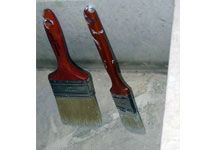 Removing fresh latex paint from a paint brush. Run the water a little warmer than room temperature. If it’s too hot, you can affect the glue that holds the bristles in place, but if it’s too cold, you’ll have a hard time getting the paint off the bristles. Fill the bucket or sink with water, and add a few drops of your dish detergent. One by one, submerge the brushes in the water and work the paint off with your fingers. Depending on how much paint was on them when you started, you may need to change out your soapy water. You should be able to clean two or three brushes before changing the water. At all costs, you should avoid submerging wooden handles to avoid warping or cracking. Rinse the brushes in running water and shake them out. Lay the paint brush on the towel, fold it over the bristles, and press down gently to squeeze out any excess water. Then, put the brush in an out of the way place to dry.
Removing fresh latex paint from a paint brush. Run the water a little warmer than room temperature. If it’s too hot, you can affect the glue that holds the bristles in place, but if it’s too cold, you’ll have a hard time getting the paint off the bristles. Fill the bucket or sink with water, and add a few drops of your dish detergent. One by one, submerge the brushes in the water and work the paint off with your fingers. Depending on how much paint was on them when you started, you may need to change out your soapy water. You should be able to clean two or three brushes before changing the water. At all costs, you should avoid submerging wooden handles to avoid warping or cracking. Rinse the brushes in running water and shake them out. Lay the paint brush on the towel, fold it over the bristles, and press down gently to squeeze out any excess water. Then, put the brush in an out of the way place to dry.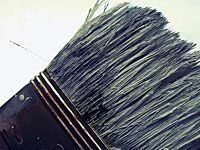 Removing old latex paint from a paint brush. Getting rid of the old, dried on paint has the same basic principle as fresh paint, but with a few changes. You’ll want to use water that’s a little above room temperature, and fill your bucket with only two or three inches of water for large brushes, or a glass with no more than an inch for smaller brushes. Add dish detergent to the water, and put your brushes in, bristles down, leaning against the walls of the bucket at an angle. Let them soak for an hour or so before going through the rest of steps from the fresh latex paint section.
Removing old latex paint from a paint brush. Getting rid of the old, dried on paint has the same basic principle as fresh paint, but with a few changes. You’ll want to use water that’s a little above room temperature, and fill your bucket with only two or three inches of water for large brushes, or a glass with no more than an inch for smaller brushes. Add dish detergent to the water, and put your brushes in, bristles down, leaning against the walls of the bucket at an angle. Let them soak for an hour or so before going through the rest of steps from the fresh latex paint section.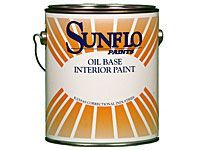 Cleaning oil-based paint from a paint brush. Oil-based paint is difficult, if only because of the nature of the chemicals required to clean oil-based paint out of paint brushes. First of all, you want to clean your brushes in a well-ventilated area. You’ll also want a pair of rubber gloves. Additionally, you need a clean glass jar, paint thinner, and an optional mask, if you’re particularly sensitive to strong fumes.
Cleaning oil-based paint from a paint brush. Oil-based paint is difficult, if only because of the nature of the chemicals required to clean oil-based paint out of paint brushes. First of all, you want to clean your brushes in a well-ventilated area. You’ll also want a pair of rubber gloves. Additionally, you need a clean glass jar, paint thinner, and an optional mask, if you’re particularly sensitive to strong fumes.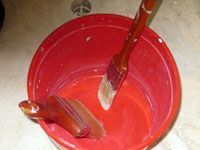 Removing new and old oil-based paint from a paint brush. When working with oil-based paints, be certain to wash your paint brushes while they are still wet. Do not allow them to dry. Put on your rubber gloves, and strap on the mask if you chose to use one. Pour just enough paint thinner into a clean glass jar to cover the affected area of the bristles. Place your brushes into the jar, and leave them to sit overnight. The next morning, don your gloves and mask again. At this point, the paint should have settled to the bottom of the jar. Very carefully, pour the perfectly reusable paint thinner back into its original container, or into another jar with a lid if you so desire. Never pour the paint thinner down the drain, as it will contaminate the ground water. There are hazardous waste disposal centers equipped for disposal of these types of materials.
Removing new and old oil-based paint from a paint brush. When working with oil-based paints, be certain to wash your paint brushes while they are still wet. Do not allow them to dry. Put on your rubber gloves, and strap on the mask if you chose to use one. Pour just enough paint thinner into a clean glass jar to cover the affected area of the bristles. Place your brushes into the jar, and leave them to sit overnight. The next morning, don your gloves and mask again. At this point, the paint should have settled to the bottom of the jar. Very carefully, pour the perfectly reusable paint thinner back into its original container, or into another jar with a lid if you so desire. Never pour the paint thinner down the drain, as it will contaminate the ground water. There are hazardous waste disposal centers equipped for disposal of these types of materials. What to do with old and used paint thinner. I recommended one way to recycle your paint thinner in the previous step. Other options include offering it to a neighbor to use, or hanging onto it for your next painting project. Sadly, there really is no good way to recycle paint thinner from home. It’s an extremely caustic chemical and is, in fact, hazardous waste. However, there are recycling centers for this purpose, and if you go to www.Earth911.com and enter what you wish to recycle and your zip code, it will tell you exactly where you can take your hazardous materials.
What to do with old and used paint thinner. I recommended one way to recycle your paint thinner in the previous step. Other options include offering it to a neighbor to use, or hanging onto it for your next painting project. Sadly, there really is no good way to recycle paint thinner from home. It’s an extremely caustic chemical and is, in fact, hazardous waste. However, there are recycling centers for this purpose, and if you go to www.Earth911.com and enter what you wish to recycle and your zip code, it will tell you exactly where you can take your hazardous materials.
Oil-Based Paint is Bad
Not to put too fine a point on it, but it is. Don’t get me wrong, it has its merits, but its flaws far outweigh its value. These days, you can find water-resistant latex paints, stains, and primers at any major home improvement store. Oil-based paints contain all manner of unseemly chemicals, such as mineral spirits, toluene, xyleneIf, and other petroleum distillates. Petroleum distillates are derived from crude oil and classified as a volatile organic compound. They are not recyclable, they are not earth-friendly, and they are generally not nice. So, if you can, avoid using oil-based paints, and switch to something that won’t slowly poison our planet.
Removing Paint from Other Surfaces
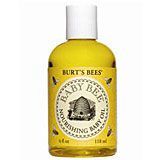 Remove oil-based paint from skin. All it takes to remove latex paint from skin is a little soap and warm water. Simply lather, rinse, and repeat. Oil-based paint is a little more difficult. Apply baby oil to that area of the skin, and let it sit for five minutes before rinsing it off with warm water. Do this a second time. When you rinse, rub your hands together like you were washing them. This should remove the paint, though it may take more than two applications. The Burt’s Bees brand has an all natural baby oil that works very well for this purpose, and it’s available at Amazon.
Remove oil-based paint from skin. All it takes to remove latex paint from skin is a little soap and warm water. Simply lather, rinse, and repeat. Oil-based paint is a little more difficult. Apply baby oil to that area of the skin, and let it sit for five minutes before rinsing it off with warm water. Do this a second time. When you rinse, rub your hands together like you were washing them. This should remove the paint, though it may take more than two applications. The Burt’s Bees brand has an all natural baby oil that works very well for this purpose, and it’s available at Amazon.
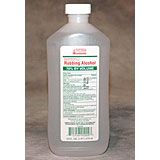 Remove oil-based paint from clothes. Again, latex paint is very easy, and a normal washing should take care of it. For oil-based paint, you don’t really want to dip your clothing into paint thinner. I’m not really sure what that would accomplish anyway. Instead, treat the affected area with rubbing alcohol (generic is fine) and you should be good to go.
Remove oil-based paint from clothes. Again, latex paint is very easy, and a normal washing should take care of it. For oil-based paint, you don’t really want to dip your clothing into paint thinner. I’m not really sure what that would accomplish anyway. Instead, treat the affected area with rubbing alcohol (generic is fine) and you should be good to go.